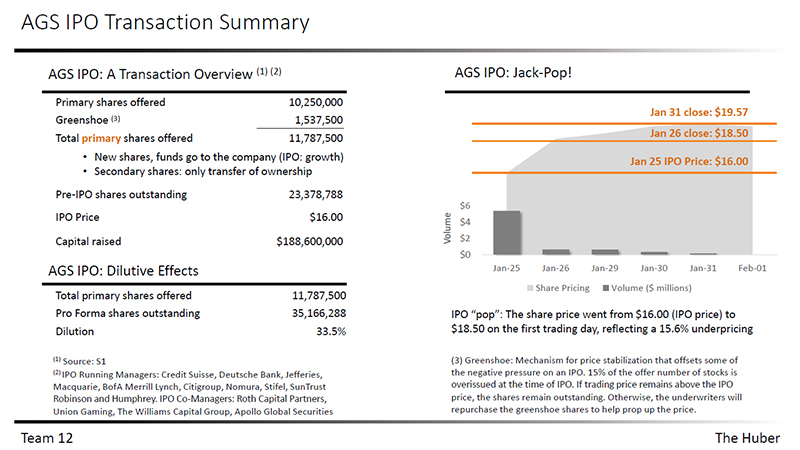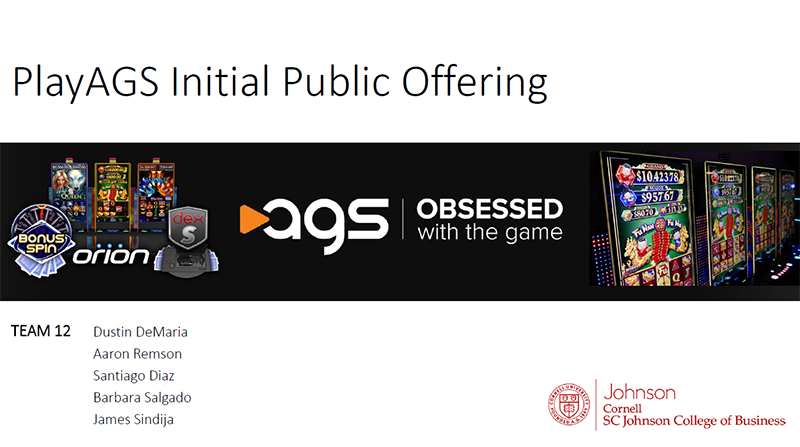AGS IPO: Casino Royale meets Investment Banking Immersion

By Santiago Diaz, Two-Year MBA ’19
It’s the official third week of the Investment Banking Immersion (IBI). I’m still recovering after the amount of work necessary for the bond offering assignment, which was an amazing learning experience due to my limited knowledge on the subject. It required learning by doing. Like clockwork, 8 a.m. dictates that a new case will be posted on Blackboard, team assignments to follow. I log in, knowing that we are going to be pitching an Initial Public Offering (IPO), which is basically a transaction where a firm issues primary shares to the public for the first time to raise capital.
I notice that the company in question is PlayAGS (NYSE: AGS). Turns out that the company went public a few days prior, and the amount of information available about the transaction was minimal: no equity research reports and only the public filings to the Securities and Exchange Commission (SEC). Enter the S1—a form firms use when they are planning to go public—to register their securities with the SEC. A wealth of information is found on the form, since it is basically a detailed look into the company as they prepare to go public.

Our assignment required a description of the transaction to a client, to find the relative valuation of the company according to their “trading comps,” and to determine whether now would be a good time to go public. Once the teams were assigned, we immediately booked time on our calendars to start working on the assignment. One dynamic that I enjoy about the IBI, is the fact that groups change with each assignment, which means that we will have the opportunity to not only get to know each other better, but also leverage our diverse backgrounds and skills.
Getting familiar with PlayAGS
We familiarized ourselves with the company as much as possible so we could determine how best to proceed. As I browsed through the S1, more information about PlayAGS became available:
- its product offering of slot machines, table games, equipment, and online social casino;
- the strong positioning of its electronic gaming machines in Native American-owned casinos,
- its high margins, and
- its development of innovative games aimed at keeping the core gambler engaged.
However, as I dove deeper into the information, I noticed its high leverage and the fact that it was fully owned by one of the funds operated by Apollo, a private equity firm. As I combed through the information, it became evident that PlayAGS was a company acquired through a leveraged buyout (traditional private equity investment strategy), and that it was trying to raise funds to pay a significant portion its debt—another strategy employed by financial sponsors to increase the internal rate of return of their investment by paying down the debt of the acquired company using the company’s generated cash, and increasing the sponsor’s equity in the company as a result.
Developing our narrative
Once we were familiar with the company, the transaction, and uses of the funds, it was time to start preparing our deck. Thankfully, the prompts provided with the cases give you enough detail regarding what is required to help prepare the narrative.
We begin to develop our narrative: we want to first give context of the equity markets, and how the IPO markets have been performing; then, we want to present what we learned about the company: competitive strengths, potential risks, as well as any other information that we may deem appropriate for our client. After the introduction to the company, we get granular—enter the numbers!
First, we summarize the IPO: how many shares were offered, including the over-allotment option (called Greenshoe); price at which the IPO was priced; total capital raised; whether there was any dilution whatsoever; and whether there was a pop after the company started trading in the stock exchange. The “pop” analysis is very interesting, because it represents a fine line of whether company and investor expectations were met, or if there was any cash left on the table by pricing the IPO too low (in our opinion, the pop was within reason).

After we analyzed the offering, it was time to determine the sources and uses of the proceeds, as well as how the capital structure of the company would look on a pro-forma basis (which basically refers to a method by which financial results are calculated and how they are reflected in a company’s financial statements). In this part of the analysis, having a team with diverse skills becomes valuable. While we made a very good effort in creating the foundation of the analysis, one of my teammates identified additional details that needed to be included, since he had a previous background in financial analysis that became very important when trying to accurately depict how the company’s capital structure looked like and how it would be affected.

We needed to provide a relative valuation of AGS using trading comps, which involved identifying companies similar to AGS, and calculating financial metrics to be used in the valuation. It may sound cliché to re-assert the old adage that “valuation is more art than science,” but selecting the comparable universe is definitely part of it. The idea here is to not only select comparable companies that have shares of stock trading in public markets (hence, trading comps), but to also select companies that are leaders in that space, so one could potentially “compare” the company one is trying to value with a company that is a leader in the industry. Once the relative valuation was done, and we determined the comparative and implied value of AGS using metrics provided by the comps, we put together the PowerPoint presentation and made final adjustments prior to the 11:59 p.m. deadline on Sunday—final adjustments done and the deck was sent! Now, it was time to prepare for a potential presentation in front of Drew Pascarella, lecturer of finance, and Robert Symington, visiting senior lecturer of finance, from the Investment Research and Asset Management (IRAM) immersion.
Presentation ready!
Monday before the sections, bankers are a little anxious because we know that any two teams could be chosen at random to present their findings to Drew in front of the class—I like to use the term “grilled.” As the hour approached, I engaged some of my classmates for feedback, since our team belonged to the later section. There are two sections, and teams in both will pitch before we all reconvene for debriefing and general comments from Drew. After the positive feedback was received, I went to my respective section, and lo and behold: Our team is called first!
I make eye contact with my team. Some seem anxious; others aren’t sure how we’ll do. However, I glance at them and wink to instill some confidence—I enjoy high pressure environments, and my previous role prior to business school prepared me to pitch to clients. Sure, I fumbled initially trying to get the PDF of our deck to project on a full screen, and the whole class laughed… that should ease the tension felt by some of my team members. Slide deck on full screen and we are a go!

Energetically, I set the tone of the presentation by introducing our team, the context of our presentation, and what the audience will experience. I provide market updates, and immediately proceed to update the audience that the charts do not reflect the turbulence that was experienced in the markets earlier in the day. Drew seemed to appreciate the update, but then continued to ask a question about one of the charts and whether we considered another aspect of the analysis—I answered that we just focused on that, and that we didn’t cover what he asked. This was fine, since it is stressed heavily by Drew to admit that one doesn’t know something as opposed to guessing. Afterwards, my team members took turns presenting their findings, but since this is a team effort, we sometimes jumped in to complement answers. It went well. Yes, we could have improved certain aspects of the deck and of our analysis, but we as a team were satisfied with the work we produced, and how far we’ve come since the beginning of the Immersion, let alone the first year of business school.
The icing on the cake came during the debrief when Drew invited a managing director within Citi’s Equity Capital Markets division through videoconference to walk us through the AGS IPO, how the process works, some of the things one would look at in practice, and then proceeded to answer questions from my classmates.
I can’t wait for the transactions that follow and to hit the ground running this summer on Wall Street!


1 Comment
Samiul Rabbi
Very thoroughly put. Go Santi!
Comments are closed.